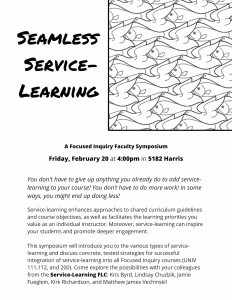Curiouser and Curiousest

One key concept from Curious is the difference between diversive and epistemic varieties of curiosity. The former involves flitting from idea to idea in the manner of surfing the web, as it used to be called, and the latter is deeper, sustained engagement with a particular issue. Leslie recommends, as I do in my course, that diversive curiosity be harnessed and converted to epistemic inquiry. I usually introduce this notion to students by contrasting seeking information with investigating an issue, yet maybe I’m not doing justice to diversive curiosity. Leslie associates the diversive with mysteries, and points out that one may read mystery stories with an intense desire to know and enjoy a journey of some length leading to its conclusion. Epistemic curiosity is characterized by asking how and why questions, which I have students refer to as “issue questions,” in line with the textbook I use. So I was pleased to see that asking probing questions was central to Leslie’s notion of curiosity.
The final chapter of the book is indeed prescriptive, titled “Seven Ways to Stay Curious.” But what I found more fascinating was Leslie’s treatment of why some people are more curious than others, an exploration he skillfully handles without resorting to overgeneralization. Early in the book he describes the Need for Cognition (NFC) questionnaire, 18 statements about feelings associated with the work of thinking that can be used as an indicator of how curious a person may be. Here are a few sample statements:
- I would rather do something that requires little thought than something that is sure to challenge my thinking abilities.
- I really enjoy a task that involves coming up with new solutions to problems.
- I usually end up deliberating about issues even when they do not affect me personally.
- I prefer to think about small, daily projects to long-term ones.
I could see referencing the NFC test in my class and debating its merits. The test itself doesn’t explain why people would agree or disagree with these statements, though it could prompt such thinking. Leslie spends a chapter of his book describing a “sweet spot” for curiosity, which depends on the level of one’s surprise, knowledge, and confidence. Simply put, if any of these three qualities are too high or too low, people tend to be overwhelmed or underwhelmed rather than productively curious. Leslie is careful to highlight that curiosity thrives in the presence of what Robert Bjork calls desirable difficulties, or enhanced learning that comes from having to think hard. He shows, too, that curiosity involves being in the moment, willing to entertain new ideas and follow thoughts where they lead, without makes long-term investment in an inquiry possible. Merely setting progress goals or imagining future rewards, in other words, is not enough.
The relationship of knowledge to curiosity is a particular emphasis of Leslie’s. He points out repeatedly that if a person doesn’t have a base knowledge of an issue, there will be no foundation for epistemic curiosity. He disagrees with those who feel that curiosity is best encouraged by deemphasizing the imparting of information to students (e.g., think of Paulo Freire’s banking education versus T-shaped skills rooted in expertise). In fact, he argues that social hierarchies are entrenched by lack of access to knowledge:
“[C]uriosity, like other thinking skills, cannot be nurtured, or taught, in the abstract. Rather than being stifled by factual knowledge, it depends on it. Until a child has been taught the basic information she needs to start thinking more deeply about a particular subject, it’s hard to develop her initial (diversive) curiosity into enduring (epistemic) curiosity … The curiosity of children dissipates when it doesn’t get fed by knowledge, imparted by parents and teachers. Even when they find something interesting to begin with, children without adequate background knowledge of a subject will soon give up on learning about it, deciding that it’s just “not for me.” Knowledge gives curiosity staying power.”
Thus youth who have not amassed a store of information are put at a disadvantage that only grows as they age. This circumstance is exacerbated, Leslie shows, by the fact that those of higher socioeconomic classes encourage questioning among their children, especially higher level how and why explorations. It would be interesting to take up with students the matter of institutional advantages and disadvantages in light of curiosity, if it could be done in such a way that it doesn’t reinforce fatalism or self-handicapping. I may at least offer students the block quotation above to solicit their thoughts.
This view of knowledge explains Leslie’s attitude to the Web as a resource. The Internet and social media can be used profitably to build one’s base knowledge, yet reliance on the Web alone may only exercise diversive curiosity. So although Leslie acknowledges concerns that technology may stifle curiosity, he believes the determining factor will be how the Web is put to use. This is a safe conclusion. In this context I would have rather he returned to points he made about family upbringing and education that show that ultimately there is a social dimension to the means and ends of technology. You can teach someone how to use the Web to gather information for herself, or you can use the Web to collaborate, which changes the equation entirely. Leslie remains focused on an individual’s curiosity when perhaps what we need to consider more is how curiosity is externalized and shared. I know this is important to my colleagues and me because we want to promote a culture of curiosity within and beyond the classroom.


No comments yet.
Add your comment